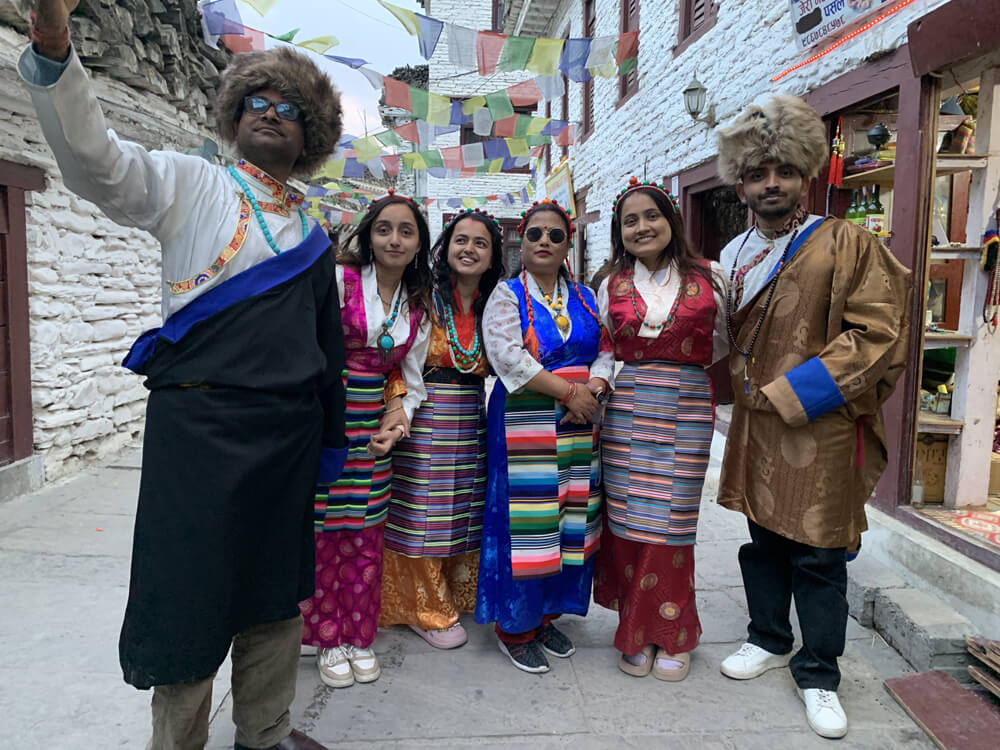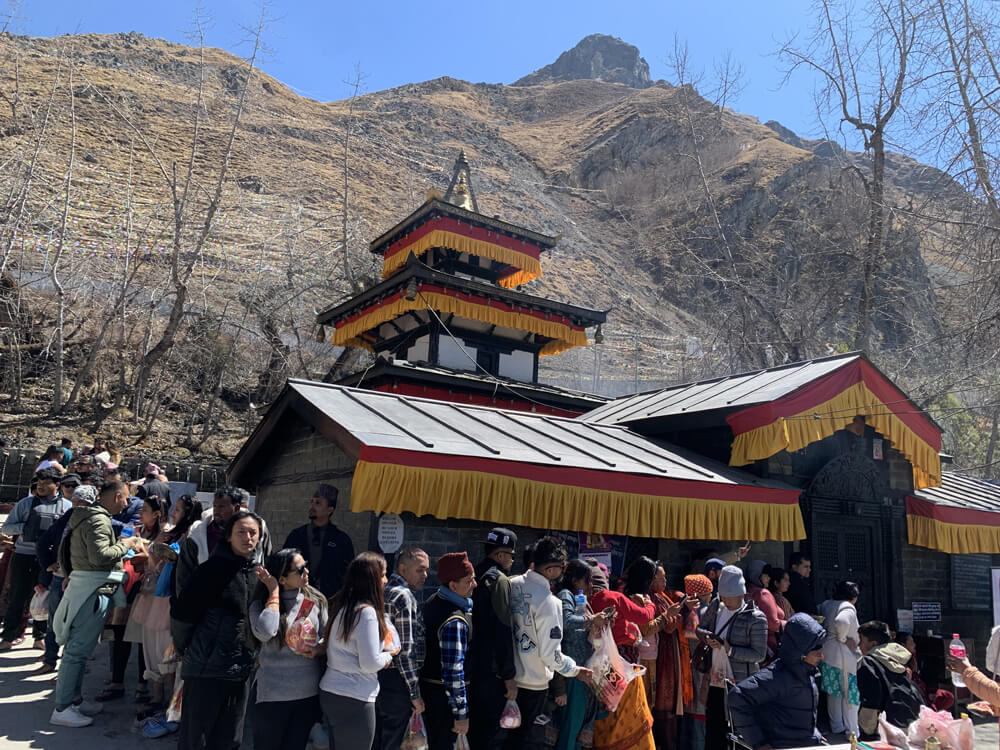Looking for a thrilling and comfortable way to explore the sacred land of Muktinath? Join our Muktinath Jeep Tour and experience a seamless journey through stunning landscapes and cultural richness, all while enjoying the comfort of a 4x4 jeep!
Read More: Pokhara to Muktinath Jeep Tour
Watch Trip Video: Pokhara to Jomsom Muktinath Video
Why Choose the Muktinath Jeep Tour?
- Skip the long treks but still experience the beauty and spirituality of Muktinath
- A perfect tour for pilgrims, nature lovers, and adventure enthusiasts alike
- Explore off-the-beaten-path destinations with ease and comfort
Pokhara to Jomsom Muktinath Road Condition
Pokhara to Beni: The road is mostly paved but can be narrow and winding, especially as you get closer to the mountainous areas. It's a paved, albeit bumpy, route.
Beni to Jomsom: The road from Beni to Jomsom is a mix of gravel and dirt roads; and is often in poor condition, especially during the monsoon season. This part of the journey can be rough, with potholes, landslides, and dust.
Jomsom to Muktinath: The road Condition from Jomsom to Muktinath is fine and well paved. It takes about 30 minutes to reach Muktinath from Jomsom, however, the time depends on the exploration stop above the Kagbeni viewpoint.

Accommodation in Muktinath Jeep Tour
Muktinath, a sacred pilgrimage site in Nepal, offers a variety of accommodation options for tourists. While the area is relatively remote, it has developed several choices for visitors, including basic guesthouses, lodges, and some mid-range hotels. Here are some accommodation options for a tour to Muktinath:
Guesthouses and Lodges:
Simple, Budget-Friendly: Most accommodations in Muktinath are simple guesthouses or lodges. These provide basic facilities such as a bed, hot water, and sometimes Wi-Fi. These are mostly aimed at trekkers and pilgrims and are perfect for those looking for an affordable stay.

Mid-Range Hotels:
If you're looking for slightly more comfort, there are a few mid-range hotels in the area, particularly around Jomsom, which is the gateway town to Muktinath. These offer more amenities, such as better rooms, heating, and sometimes even a more varied menu.
Tea Houses:
Along the trekking route, there are also tea houses that provide accommodation and food. These are geared towards trekkers and provide a comfortable, local experience.
Luxury Options:
There are very few luxury accommodations in Muktinath due to its remote location. However, in places like Jomsom and Pokhara (a longer distance from Muktinath), you can find upscale hotels or resorts, if you prefer a more luxurious experience before or after the trek.
Key Attractions on the Muktinath Jeep Tour
Rupse Waterfall
is a 310-meter cascading waterfall, which is closely located at the site of the deepest gorge in the world- the Kali Gandaki Gorge. Travelers don't pass this attraction without stopping by it and taking an abundant number of pictures.
Marpha Gully and Traditional Dresses
The Thakali dress of Marpha is a traditional attire worn by the Thakali people, an ethnic group from the Mustang region of Nepal, particularly around the area of Marpha. This distinctive dress is a reflection of their rich cultural heritage and the region's unique history. The attire is both functional and symbolic, showcasing their lifestyle, social status, and the natural environment around them.
For Women (Traditional Thakali Dress):
Top (Cholo or Blouse): The top is a fitted blouse or cholo, typically made of brightly colored fabrics such as red, green, or blue. It is often embroidered with intricate patterns, especially around the neck and sleeves. In the colder months, women may also wear a long-sleeved version of the blouse.
Skirt (Gunyo or Falda): The skirt or gunyo is a long, flowing piece of fabric tied around the waist. It’s often made from heavy woolen or cotton fabric, depending on the season. The color of the skirt can range from solid hues to patterned fabrics.
Shawl (Dhoti or Chadar): A colorful shawl or chadar is draped over the shoulders. This is often used to protect from the harsh winds and cold weather in the high-altitude regions.
Jewelry: Women typically wear traditional jewelry, which includes silver necklaces, earrings, and bracelets. The most iconic jewelry is the "Thakali-style necklace", which is large, composed of multiple chains, and sometimes adorned with religious symbols like Buddha or deities.
Headwear (Topi): A simple woolen cap or head scarf is often worn to complete the look, especially when going out to the fields or on religious occasions.
Footwear: Traditional leather sandals or boots made from animal skin are worn, reflecting the practical nature of their attire.

For Men (Traditional Thakali Dress):
Top (Kurta): The traditional dress for men includes a kurta, a long shirt with a loose fit, usually paired with a vest. The kurta is made from cotton or woolen fabrics depending on the season.
Trousers (Chupka): The pants or chupka are typically a loose-fitting style, which is practical for the rugged terrain of the Mustang region.
Shawl: Similar to the women’s outfit, men also wear a shawl or chadar, often draped over one shoulder, which helps protect from the cold weather and adds a traditional touch.
Footwear: Men also wear leather sandals or boots, similar to those worn by women.
Headgear (Topi): A distinctive feature of the Thakali men’s dress is the Nepali cap (topi). It is made from fabric and fits snugly on the head. The topi is often worn during religious ceremonies or formal occasions.
Accessories and Additional Items:
Mala (Prayer Beads): Many Thakali people wear mala or prayer beads, reflecting the Buddhist faith, as the majority of the Thakali people are Tibetan Buddhists. The beads are often worn as necklaces or carried in the hands during religious rituals.
Belt or Sash: A decorative belt or sash is worn by both men and women, sometimes made of intricate fabric, to hold the skirt or trousers in place.
Woolen Fabrics: Due to the cold climate of the region, woolen materials are essential in the construction of these dresses. These fabrics are woven locally, ensuring warmth and comfort.
View from Marpha
Dhumba Lake
Dhumba Lake is situated around 3 kilometers (1.8 miles) north of Jomsom, at an elevation of 2,920 meters (9,577 feet) above sea level.
The lake lies at the foot of the Dhaulagiri Mountain Range, with stunning views of Mt. Dhaulagiri and the Annapurna Range in the background, adding to the lake’s natural beauty.
It can be reached by a short hike from Jomsom, making it a perfect stop for trekkers or those on a pilgrimage to Muktinath. The walk to the lake offers a peaceful journey through the rugged terrain, surrounded by beautiful landscapes.
.jpg)
Beautiful Hotel Attraction at Kagbeni
Welcome to Kagbeni, a historical town in the Lower Mustang region, beautifully located at the juncture of the Kali Gandaki River and a stream that comes from Muktinath. Kagbeni was a bustling and a crowded trade town during the salt trading time in Mustang. Kagbeni is an extremely popular destination for Hindu devotees to perform Shradda Ritual (memorial ritual of ancestors). This beautiful picture is of Hotel Yak Donald, which is not only colorful; but also built with special decoration.
Muktinath Temple (3800 meters altitude)
Hinduism: For Hindus, Muktinath is considered a holy site where devotees come to seek liberation (Moksha) from the cycle of life and death. The temple is dedicated to Lord Vishnu, who is worshipped here in the form of the deity Muktinath, also known as the "Lord of Liberation."
Buddhism: The temple is also highly revered by Buddhists. The site is associated with the Tibetan Buddhist tradition and is considered a sacred place of pilgrimage, where many Tibetans come to pray and meditate.
The Muktinath Temple itself is a small, stone-built shrine. It features a bronze statue of Lord Vishnu (Muktinath) inside, where devotees offer prayers, flowers, and other offerings.
Surrounding the temple are 108 water spouts (called "Muktidhara"), from which cold water flows continuously. These spouts are considered sacred, and pilgrims often take a ritual bath under them to cleanse their sins.
The temple complex is often surrounded by a circular courtyard, and there are small shrines, prayer wheels, and Buddhist stupas scattered around the area.
 For Kathmandu/Pokhara to Jomsom Muktinath Tour booking,
For Kathmandu/Pokhara to Jomsom Muktinath Tour booking,
WhatsApp: +977 9851159455
Email: [email protected]

-0.JPG)
.JPG)
.JPG)
.JPG)
.JPG)
.JPG)
.JPG)
.JPG)
